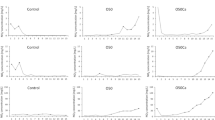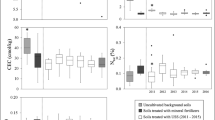Abstract
The aim was to study the influence of soil properties on the leaching of nitrate, phosphate and organic matter (OM) following the application of sewage sludge to contrasting soils. Seventy agricultural soils from different parts of Spain were amended with sewage sludge (50 t dry weight ha−1), and a controlled column study was developed. After 2, 4 and 6 months of incubation, distilled water, equivalent to an autumn rainfall event of 25 l m−2 in Mediterranean environments, was applied and leachates collected and analysed: pH, electrical conductivity (EC), chemical oxygen demand (COD), phosphate and nitrate. The mean values of pH in the leachates after 2, 4 and 6 months were similar and close to the neutrality. The highest concentrations for the rest of the parameters analysed were found after 2 months of incubation and diminished for 4 and 6 months, especially COD. Soil pH and texture were the most relevant soil properties controlling the leaching of the analysed parameters. The OM mineralization seemed to be enhanced at high values of soil pH, thus increasing the nitrate and reducing the COD leaching. However, phosphate levels were reduced at high values of soil pH. In addition, leaching was promoted in sandy soils. Other soil properties influenced phosphate leaching being the equivalent calcium carbonate soil content as the most relevant. Soil organic carbon was negatively related to the EC and nitrate concentration in the leachates but resulting in a weak contribution compared with soil pH and texture. Concerns about nitrate pollution have been confirmed.
Similar content being viewed by others
References
Almendro-Candel, M. B., Jordán, M. M., Navarro-Pedreño, J., Mataix-Solera, J., & Gómez-Lucas, I. (2007). Environmental evaluation of sewage sludge application to reclaim limestone quarries wastes as soil amendments. Soil Biology and Biochemistry, 39, 1328–1332.
Amer, F., Saleh, M. E., & Mostafa, H. E. (1991). Phosphate behavior in submerged calcareous soils. Soil Science, 151, 306–311.
Antoniadis, V., & Alloway, B. J. (2002). Leaching of cadmium, nickel, and zinc down the profile of sewage sludge-treated soil. Communications in Soil Science and Plant Analysis, 33, 273–286.
APHA. (1999). Standard methods for the examination of water and wastewater. Washington, DC: American Public Health Association.
Ashworth, D. J., & Alloway, B. J. (2004). Soil mobility of sewage sludge-derived dissolved organic matter, copper, nickel and zinc. Environmental Pollution, 127, 137–144.
Barton, L., Schipper, L. A., Barkle, G. F., McLeod, M., Speir, T. W., Taylor, M. D., et al. (2005). Land application of domestic effluent onto four soil types: plant uptake and nutrient leaching. Journal of Environmental Quality, 34, 635–643.
Bernal, M. P., Sánchez-Monedero, M. A., Paredes, C., & Roig, A. (1998). Carbon mineralization from organic wastes at different composting stages during their incubation with soil. Agriculture, Ecosystems & Environment, 69, 175–189.
Bremmer, J. M., & Mulvaney, C. S. (1982). Nitrogen total. In A. L. Page, R. H. Miller, & D. R. Keeney (Eds.), Methods of soil analysis, part 2. chemical and microbiological properties (pp. 595–624). Madison: ASA and SSSA.
Camobreco, V. J., Richards, B. K., Steenhuis, T. S., Peverly, J. H., & McBride, M. B. (1996). Movement of heavy metals through undisturbed and homogenized soil columns. Soil Science, 161, 740–750.
Chen, Y. X., Zhu, G. W., Tian, G. M., & Chen, H. L. (2003). Phosphorus and copper leaching from dredged sediment applied on a sandy loam soil: column study. Chemosphere, 53, 1179–1187.
Cooke, C. M., Gove, L., Nicholson, F. A., Cook, H. F., & Beck, A. J. (2001). Effect of drying and composting biosolids on the movement of nitrate and phosphate through repacked soil columns under steady-state hydrological conditions. Chemosphere, 44, 797–804.
Dalenberg, J. W., & Jager, G. (1989). Priming effect of some organic additions to 14C-labeled soil. Soil Biology and Biochemistry, 21, 443–448.
Díez, J. A. (1982). Consideraciones sobre la utilización de la técnica extractiva de Burriel-Hernando para la evaluación de fósforo asimilable en suelos. Anales de Edafología y Agrobiología, 41, 1345–1353.
Djodjic, F., Borling, K., & Bergstrom, L. (2004). Phosphorus leaching in relation to soil type and soil phosphorus content. Journal of Environmental Quality, 33, 678–684.
Dunnivant, F. M., Jardine, P. M., Taylor, D. L., & McCarthy, J. F. (1992). Transport of naturally occurring dissolved organic carbon in laboratory columns containing aquifer material. Soil Science Society of America Journal, 56, 437–444.
EEC/91/271 (1991) European Community Council Directive 1991/271/EEC of 21 March 1991 concerning urban wastewater treatment.
EEC/91/676 (1991) European Community Council Directive 1991/676/EEC of 12 December 1991 concerning the protection of waters against pollution caused by nitrates from agricultural sources.
Forster, J. C. (1995). Soil physical analysis. In K. Alef & P. Nannipieri (Eds.), Methods in applied soil microbiology and biochemistry (pp. 106–111). San Diego, CA: Academic.
Franzluebbers, A. J. (1999). Microbial activity in response to water-filled pore space of variably eroded southern Piedmont soils. Applied Soil Ecology, 11, 91–101.
Funakawa, S., Makhrawie, M., & Pulunggono, H. B. (2009). Soil fertility status under shifting cultivation in East Kalimantan with special reference to mineralization patterns of labile organic matter. Plant and Soil, 319, 57–66.
Gee, G. W., & Bauder, J. W. (1986). Particle-Size Analysis. In A. Klute (Ed.), Methods of soil analysis 1: physical and mineralogical methods (2nd ed., pp. 383–411). Madison: ASA and SSSA.
Houba, V. J. G., Van der Lee, J. J., Novozamsky, I., & Walinga, I. (1989). Soil and plant analysis, a series of syllabi. Part 5, Soil analysis procedures. Wageningen Agricultural University, The Netherlands.
Hulseman, J. (1966). An inventory of marine carbonate materials. Journal of Sedimentary Petrology ASCE, 36, 622–625.
James, D. W., Hotuby-Amacher, J., Anderson, G. L., & Huber, D. A. (1996). Phosporous mobility in calcareous soils Ander heavy manuring. Journal of Environmental Quality, 25, 770–775.
Johansson, G. (1998). Chemical fixation of ammonia to soil organic matter after application of urea. Acta Agriculturae Scandinavica Section B, Plant & Soil Science, 48, 73–78.
Jordán, M. M., Pina, S., García-Orenes, F., Almendro-Candel, M. B., & García-Sánchez, E. (2008). Environmental risk evaluation of the use of mine spoils and treated sewage sludge in the ecological restoration of limestone quarries. Environmental Geology, 55, 453–462.
Kaschl, A., Römheld, V., & Chen, Y. (2002). The influence of soluble organic matter from municipal solid waste compost on trace metal leaching in calcareous soils. Science of the Total Environment, 291, 45–57.
Kessavalou, A., Doran, J. W., Powers, L., Kettler, T. A., & Qian, J. H. (1996). Bromide and nitrogen-15 tracers of nitrate leaching under irrigated corn in central Nebraska. Journal of Environmental Quality, 25, 1008–1014.
Luo, Y., & Zhou, X. (2006). Soil respiration and the environment. Elsevier: Academic.
Moral, R., Navarro-Pedreño, J., Gómez, I., & Mataix, J. (1996). Quantitative analysis of organic residues: effects of samples preparation in the determination of metal. Communications in Soil Science and Plant Analysis, 27, 753–761.
Navarro-Pedreño, J., Almendro-Candel, M. B., Jordán-Vidal, M. M., Mataix-Solera, J., & Garcia-Sánchez, E. (2003). Mobility of cadmium, chromium, and nickel through the profile of a calcisol treated with sewage sludge in the southeast of Spain. Environmental Geology, 44, 545–553.
Nelson, D. V., & Sommers, L. E. (1982). Total carbon, organic carbon, and organic maatter. In A. L. Page (Ed.), Methods of soil analysis, part 2 chemical and biological methods (pp. 539–579). Madison: ASA and SSSA.
Qiang, Z., Speir, T. W., & Van Schaik, A. P. (2004). Leaching of nutrients from soil cores treated with a single large dose of digested sewage sludge. Biology and Fertility of Soils, 40, 284–289.
Römkens, P. F., Bril, J., & Salomons, W. (1996). Interaction between Ca2+ and dissolved organic carbon: implications for metal mobilization. Applied Geochemistry, 11, 109–115.
Sahrawat, K. L. (2008). Factors affecting nitrification in soils. Communications in Soil Science and Plant Analysis, 39, 1436–1446.
Santibañez, C., Ginocchio, R., & Varnero, M. T. (2007). Evaluation of nitrate leaching from mine tailings amended with biosolids under Mediterranean type climate conditions. Soil Biology and Biochemistry, 39, 1333–1340.
Sempere, A., Oliver, J., & Ramos, C. (1993). Simple determination of nitrate in soils by second-derivative spectroscopy. Journal of Soil Science, 44, 633–639.
Shepherd, M. A. (1996). Factors affecting nitrate leaching from sewage sludges applied in a sandy soil in arable agriculture. Agriculture, Ecosystems & Environment, 58, 171–185.
Siddique, M. T., Robinson, J. S., & Alloway, B. J. (2000). Phosphorous reactions and leaching potential in soil amended with sewage sludge. Journal of Environmental Quality, 29, 1931–1938.
Smith, K. A., Chalmers, A. G., Chambers, B. J., & Christie, P. (1998). Organic manure phosphorus accumulation, mobility and management. Soil Use & Management, 14, 154–159.
Speir, T. W., Van Schaik, A. P., Percival, H. J., Close, M. E., & Pang, L. (2003). Heavy metals in soil, plants and groundwater following high-rate sewage sludge application to land. Water, Air, and Soil Pollution, 150, 319–358.
Tisdale, S. L., Nelson, W. L., Beaton, J. D., & Havlin, J. L. (1993). Soil fertility and fertilizers (5th ed., pp. 186–204). Englewood Cliffs: Prentice-Hall.
Toribio, M., & Romanyà, J. (2006). Leaching of heavy metals (Cu, Ni and Zn) and organic matter after sewage sludge application to Mediterranean forest soils. Science of the Total Environment, 363, 11–21.
Vogeler, I., Green, S. R., Mills, T., & Clothier, B. E. (2006). Modelling nitrate and bromide leaching from sewage sludge. Soil & Tillage Research, 89, 117–184.
Wang, W. J., Dalal, R. C., Moody, P. W., & Smith, C. J. (2003). Relationships of soil respiration to microbial biomass, substrate availability and clay content. Soil Biology and Biochemistry, 35, 273–284.
Wong, J. W. C., Cheung, K. C., & Wong, M. H. (2000). Environmental implication of soils amended with anaerobically digested sewage sludge in Hong Kong. Water, Air, and Soil Pollution, 124, 23–36.
Yang, Y., He, Z., Stoffella, P. J., Yang, X., Graetz, D. A., & Morris, D. (2008). Leaching behavior of phosphorus in sandy soils amended with organic material. Soil Science, 173, 257–266.
Acknowledgements
This work was supported by the Spanish Ministry of Environment (number of expedient: 021/2006/2-4.2). José M. Soriano gratefully acknowledges the Spanish Ministry of Science and Innovation for a research fellowship (AP2005-0320).
Author information
Authors and Affiliations
Corresponding author
Rights and permissions
About this article
Cite this article
Soriano-Disla, J.M., Gómez, I. & Navarro-Pedreño, J. The Influence of Soil Properties on the Water Pollution (Nitrate, Phosphate and COD) Following a Single Application of Sewage Sludge to 70 Contrasting Agricultural Soils. Water Air Soil Pollut 223, 1783–1790 (2012). https://doi.org/10.1007/s11270-011-0983-6
Received:
Accepted:
Published:
Issue Date:
DOI: https://doi.org/10.1007/s11270-011-0983-6




